Abstract Video: The Moving Image in Contemporary Art
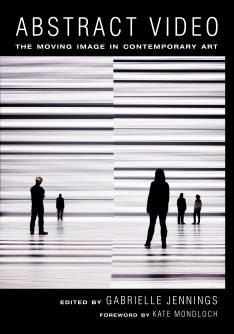
Abstract Video: The Moving Image in Contemporary Art, edited by Gabrielle Jennings (UC Press, 2015)
Thursday October 15, 2015, 7:30 pm
At LACE, 6522 Hollywood Blvd., Los Angeles CA 90028
Gabrielle Jennings in person!
Filmforum is pleased to present a program of works highlighting artists featured in the recent publication, Abstract Video: The Moving Image in Contemporary Art, edited by Gabrielle Jennings and published by the University of California Press. This groundbreaking volume includes a diverse set of essays centered on the question of abstraction in the moving image arts.
Like the book, this program is a diverse consideration of how the abstract is manifested in the moving image arts. The program covers a broad mix of contemporary and historical works drawing on the essays featured in the book, and representing the breadth, depth and variety the volume has to offer. Works screened will include pure filmic abstractions, handmade and computer generated animation, eccentric digital image manipulation, and submerged narratives from artists that include: Pierre Huyghe, Lynn Marie Kirby, Lutz Becker, Stan Brakhage, Robert Breer, Ariel Jackson, Jennifer West, John Whitney, Jud Yalkut and Nam June Paik, among others. Program co-curated by Gabrielle Jennings and Mark Toscano.
About the Book - Abstract Video: The Moving Image in Contemporary Art
Offering historical and theoretical positions from a variety of art historians, artists, curators, and writers, this groundbreaking collection is the first substantive sourcebook on abstraction in moving-image media. With a particular focus on art since 2000, Abstract Video addresses a longer history of experimentation in video, net art, installation, new media, expanded cinema, visual music, and experimental film. Editor Gabrielle Jennings—a video artist herself—reveals as never before how works of abstract video are not merely, as the renowned curator Kirk Varnedoe once put it, “pictures of nothing,” but rather amorphous, ungovernable spaces that encourage contemplation and innovation. In explorations of the work of celebrated artists such as Jeremy Blake, Mona Hatoum, Pierre Huyghe, Ryoji Ikeda, Takeshi Murata, Diana Thater, and Jennifer West, alongside emerging artists, this volume presents fresh and vigorous perspectives on a burgeoning and ever-changing arena of contemporary art.
The book features:
Foreword: Kate Mondloch,
Contributors: John G. Hanhardt, John Welchman, Siona Wilson, Jeremy Gilbert-Rolfe, Cindy Keefer, Gregory Zinman, Michael Connor, Johanna Gosse, Tilman Baumgärtel, Sarah Cook, Charlotte Frost, and Caitlin Jones, Katja Kwastek, Lumi Tan, Christine Ross, Maria-Christina Villaseñor, Trinie Dalton, Stanya Kahn, and Philip Brophy
http://www.ucpress.edu/book.php?isbn=9780520282483
Gabrielle Jennings is a multi-media artist and Associate Professor teaching in the Graduate Art program at the ArtCenter College of Design in Pasadena. Most recently, Jennings has edited a collection of essays for University of California Press Abstract Video: The Moving Image in Contemporary Art. This groundbreaking volume includes a diverse set of essays centered around the question of abstraction in the moving image arts. http://www.gabriellejennings.com/
For more event information: www.lafilmforum.org, or 323-377-7238
Tickets: $10 general, $6 students/seniors/LACE members; free for Filmforum members. Available by credit card in advance from Brown Paper Tickets at http://bpt.me/2371865 or at the door.
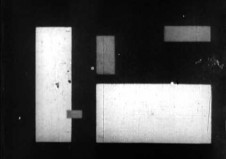
Rhythmus 21, by Hans Richter
Rhythmus 21
By Hans Richter, ca.1923, 3.5 min.
"The simple square of the movie screen could easily be divided and 'orchestrated’… These divisions or parts could then be orchestrated in time by accepting the rectangle of the 'movie canvas' as the form element. In other words, I did again with the screen what I had done years before with the canvas. In doing so I found a new sensation: rhythm—which is, I still think, the chief sensation of any expression of movement." – Hans Richter, 1952
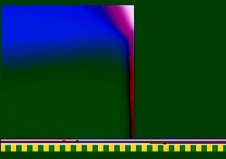
Jacaranda Tree Chalon Road Exposure: Brazilian Export, by Lynn Marie Kirby
Jacaranda Tree Chalon Road Exposure: Brazilian Export
By Lynn Marie Kirby (2004, digital, color, silent, 4.5m)
"In her new series of 'Latent Image Excavations,' [Kirby] investigates the American landscape by exposing 16mm film stock at different sites, without a camera, absorbing the light of carefully chosen locations. The developed film is then manipulated through a film-to-digital transfer machine. She literally performs the material as it is being transferred, using the machine in a unique way that retains both unpredictable film artifacts—splices, sprocket holes, scratches, leader lettering—and digital ones: icons embedded in the machine, geometric color bars and fields, as well as the indications of fast forwarding and technical overload, all elements that are usually unwanted and unseen." (Kathy Geritz, Berkeley Art Museum/Pacific Film Archive)
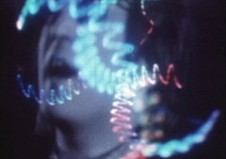
Beatles Electroniques, by Jud Yalkut & Nam June Paik
Beatles Electroniques
By Jud Yalkut & Nam June Paik (1966-69, 16mm, color, sound, 3 min.)
"BEATLES ELECTRONIQUES was shot in black-and-white from live broadcasts of the Beatles while Paik electromagnetically improvised distortions on the receiver, and also from videotaped material produced during a series of experiments with filming off the monitor of a Sony videotape recorder. The film is three minutes long and is accompanied by an electronic soundtrack by composer Ken Werner, called 'Four Loops,' derived from four electronically altered loops of Beatles sound material. The result is an eerie portrait of the Beatles not as pop stars but rather as entities that exist solely in the world of electronic media." - Gene Youngblood, Expanded Cinema
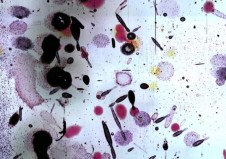
Lavender Mist Film/Pollock Film 1, by Jennifer West
Lavender Mist Film/Pollock Film 1
By Jennifer West (2009, digital, 46 seconds)
70mm film leader rubbed with Jimson Weed Trumpet flowers, spraypainted, dipped and splattered with nail polish, sprayed with lavender mist air freshener. – Jennifer West
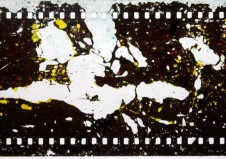
Salt Crystals Spiral Jetty Dead Sea Five Year Film, by Jennifer West,
Salt Crystals Spiral Jetty Dead Sea Five Year Film
Jennifer West (2013, digital, 54 seconds)
70mm film negative floated in the Dead Sea and given a healing clay bath in extreme heat in 2008 - stuffed in a suitcase, placed in studio buckets, covered in clay and salt for five years - dragged along the salt encrusted rocks of the Spiral Jetty and thrown in the pink waters in 2013 in below 10 degree weather - Dead Sea floating and mud baths by Mark Titchner, Karen Russo and Jwest - Spiral Jetty dragging and rolling by Aaron Moulton, Ignacio Uriarte and Jwest - DIY telecine frame by frame of salt covered film by Chris Hanke. – Jennifer West
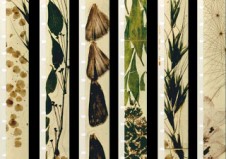
Mothlight, by Stan Brakhage
Mothlight
By Stan Brakhage (1963, 16mm, color, silent 24fps, 3.5m)
"Essence of lepidoptera re-created between two strips of clear mylar tape: an anima animation. What a moth might see from birth to death if black were white and white were black." - Stan Brakhage
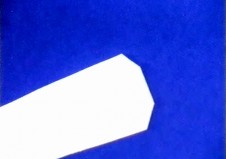
69, by Robert Breer
69
By Robert Breer (1968, 16mm, color, sound, 4.5m)
"69 undoes itself. It starts out like a system, then the system breaks down and goes to hell. During the editing I came up with the idea that it should break down, so I shuffled the cards. I thought it served me right to undo my own pretence at formal purity." - Robert Breer
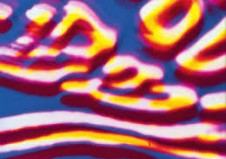
Horizon, by Lutz Becker
Horizon
By Lutz Becker (1966, digital (orig 16mm), color, sound, 5 min.)
"Lutz Becker made this film while working experimentally with BBC electronics engineer Ben Palmer. Becker hoped ‘we might find some kind of equivalent to electronic music. We explored ways in which visual effects could be created through utilizing a feedback circle between .. TV cameras and monitors’. Made in the age of black and white TV, the film had colour added later in an optical film printer. It was transmitted by the BBC in 1969." - Tate Britain
Blanche-Neige Lucie (Snow White Lucie)
By Pierre Huyghe (1997, video, color, sound, 3.5m)
Huyghe’s film Blanche Neige Lucie focuses on Lucie Dolène, the woman who provided the voice for Disney’s French version of Snow White and the Seven Dwarfs (1937)... ‘When I gave my voice to that character,’ she says, ‘that beautiful little princess, graceful and innocent, I was Snow White ... Yes, absolutely ... Today when I watch the film I have a strange feeling, it’s my voice and yet it doesn’t seem to belong to me anymore, it belongs to the character and to the story.’ Perhaps, but in Blanche Neige Lucie she challenges Snow White with Snow White’s voice, reinhabits her own creation, haunts herself." - Tom Morton, Frieze, April 2003. Special thanks to Marian Goodman Gallery.
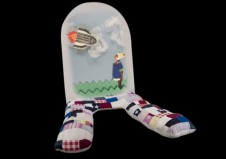
Here’s Hoping (AKA The Blues), by Ariel Jackson
Here’s Hoping (AKA The Blues)
By Ariel Jackson (2013, 7.5 min.)
"'How can we protect our colors so we don't have to give them to somebody else?'
Confuserella dislocates herself in order to answer this question after experiencing a natural disaster." - Ariel Jackson
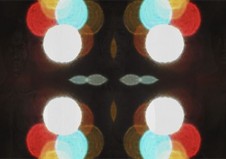
The Promise of Light, by Rico Gatson
The Promise of Light
By Rico Gatson (2013, digital video, color, sound, 8 min.)
"The Promise of Light combines footage of atmospheric light and sound layered upon graphic historic imagery. The light in the video is transitional, alluding to journey, transformation, and the passage of time." -Ronald Feldman Fine Arts. Courtesy of Ronald Feldman Fine Arts, New York.

Permutations, Photo © John Whitney 1968. © renewed 2015 by Whitney Editions™. All rights reserved.
Permutations
By John Whitney, 1968, 16mm film, color, sound, 8 min.
John Whitney © 1968. Copyright renewed 2015 by Whitney Editions™
"An utterly formative computer animation classic, Permutations is an early apotheosis of John Whitney’s deep- and far-reaching ideas about image, motion, and the complementarity of music and visual art." - Mark Toscano
